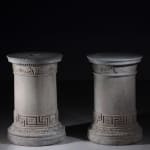Open a larger version of the following image in a popup:
 Chambers design drawing in the V&A
Chambers design drawing in the V&A
 Chambers design drawing in the V&A
Chambers design drawing in the V&A
A Pair of Neoclassical Marble Pedestals (SOLD)
An Important pair of marble pedestals to a design by Sir William Chambers
English, Circa 1775-1790
Cylindrical white marble pedestals: moulded tops with egg-and-dart above a frieze of bucrania linked by beaded garlands and rosettes; plain drums; lower band with Greek key panels centres by square rosettes; stepped soles with enriched leaf and bead mouldings.
Provenance: part of an established private collection in the UK.
Context and drawings:
The design corresponds directly with Chambers drawings preserved at the V&A museum , a finished wash elevation of this exact pedestal type drawn by Sir William Chambers.
The pedestals also feature again in a related sheet from Chambers' Franco-Italian Album that repeats the design in a more casual sketch.
Sir William Chambers
Chambers (1723-1796) was a leading architect of the early English neoclassical movement. Trained in Paris and Rome and later architect to George III, he served as Surveyor-General to the Board of Works, major works include Somerset House and buildings at Kew. His Treatise on the Decorative Part of Civil Architecture codified mouldings, pedestals and ornamental detail for the architects, sculptors and marble yards. The present pedestals adopt the codified language - egg-and-dart, bucrania with garlands and the meander frieze - as shown in his drawings.
Thomas Hope connection
In the early 1820s this pedestal design found fame again when Thomas Hope adopted this Chambers-derived model for the pedestal of his Canova Venus at Deepdene; both the pedestal and the sculpture are now in the National Gallery of Art, Washington (Corcoran Collection, William A.Clark Collection; acc Nos 2014.136.243 [pedestal] and 2014.136.242 [Venus]).
Column 1
Height 84.5cm
Diameter base 62cm
Diameter top 55cm
Column 2
Height 83.5cm
diameter base 60cm
Diameter top 55cm
English, Circa 1775-1790
Cylindrical white marble pedestals: moulded tops with egg-and-dart above a frieze of bucrania linked by beaded garlands and rosettes; plain drums; lower band with Greek key panels centres by square rosettes; stepped soles with enriched leaf and bead mouldings.
Provenance: part of an established private collection in the UK.
Context and drawings:
The design corresponds directly with Chambers drawings preserved at the V&A museum , a finished wash elevation of this exact pedestal type drawn by Sir William Chambers.
The pedestals also feature again in a related sheet from Chambers' Franco-Italian Album that repeats the design in a more casual sketch.
Sir William Chambers
Chambers (1723-1796) was a leading architect of the early English neoclassical movement. Trained in Paris and Rome and later architect to George III, he served as Surveyor-General to the Board of Works, major works include Somerset House and buildings at Kew. His Treatise on the Decorative Part of Civil Architecture codified mouldings, pedestals and ornamental detail for the architects, sculptors and marble yards. The present pedestals adopt the codified language - egg-and-dart, bucrania with garlands and the meander frieze - as shown in his drawings.
Thomas Hope connection
In the early 1820s this pedestal design found fame again when Thomas Hope adopted this Chambers-derived model for the pedestal of his Canova Venus at Deepdene; both the pedestal and the sculpture are now in the National Gallery of Art, Washington (Corcoran Collection, William A.Clark Collection; acc Nos 2014.136.243 [pedestal] and 2014.136.242 [Venus]).
Column 1
Height 84.5cm
Diameter base 62cm
Diameter top 55cm
Column 2
Height 83.5cm
diameter base 60cm
Diameter top 55cm
Further images
-
(View a larger image of thumbnail 1
)

-
(View a larger image of thumbnail 2
)

-
(View a larger image of thumbnail 3
)

-
(View a larger image of thumbnail 4
)

-
(View a larger image of thumbnail 5
)

-
(View a larger image of thumbnail 6
)

-
(View a larger image of thumbnail 7
)

-
(View a larger image of thumbnail 8
)

-
(View a larger image of thumbnail 9
)

-
(View a larger image of thumbnail 10
)

-
(View a larger image of thumbnail 11
)

-
(View a larger image of thumbnail 12
)











